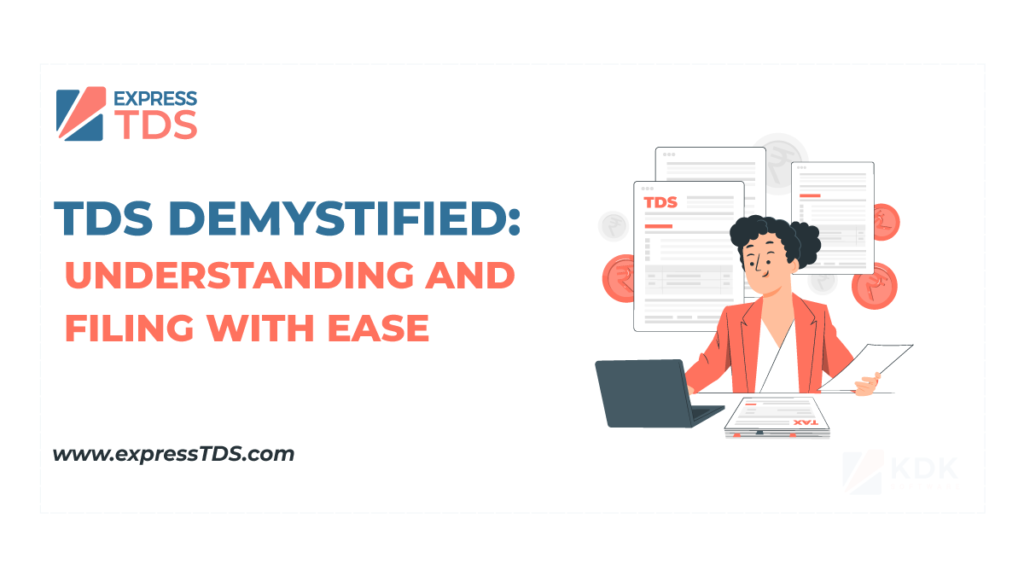How to Calculate TDS: A Simple Guide for Beginners in 2024
TDS Demystified: Understanding and Filing with Ease

Tax Deducted at Source (TDS) plays a crucial role in India’s taxation system. It ensures that the government receives tax revenue regularly and helps prevent tax evasion. As a responsible taxpayer or business, understanding the nuances of TDS and the filing requirements is essential for compliance. This comprehensive guide will cover everything you need to know about TDS filing, including what TDS is, the process of filing TDS returns, eligibility, forms, and how ExpressTDS can simplify the entire process for you.
What is TDS?
TDS stands for Tax Deducted at Source. It is a method of tax collection where a certain percentage of tax is deducted from payments made to individuals or businesses. These payments can include salaries, interest, commissions, rent, and more. The deducted amount is then deposited with the government, which helps in the collection of tax at the source of income. This system ensures that the government receives a steady stream of revenue throughout the year.
What is the TDS Return?
A TDS return is a statement submitted quarterly by the deductor to the Income Tax Department. It provides details of the TDS deducted and paid to the government. The TDS return includes information such as the Tax Deduction Account Number (TAN) of the deductor, the Permanent Account Number (PAN) of the deductees, the amount of TDS deducted, the type of payment, and the date of deduction.
What is TDS Return Filing?
TDS Return Filing refers to the process of submitting the TDS return to the Income Tax Department. This filing is mandatory for all deductors and must be done on a quarterly basis. The process involves collecting and verifying all TDS-related data, generating the TDS return using appropriate software, validating the return, and submitting it electronically. Proper TDS Return Filing ensures compliance with tax laws and helps maintain accurate financial records.
Eligibility for TDS Returns
Any individual or entity making specified payments is required to deduct TDS if the payment exceeds certain thresholds. These thresholds vary depending on the type of payment.
The following categories are generally required to deduct and file TDS returns:
- Employers paying salaries to employees
- Banks paying interest on fixed deposits
- Businesses paying rent, commission, or professional fees
- Individuals making high-value transactions
Forms to File Annual, Quarterly TDS and TCS Returns
Different forms are used for filing TDS and TCS returns based on the type of transaction and the nature of the payment. The main forms are:
- Form 24Q: For TDS on salaries
- Form 26Q: For TDS on payments other than salaries
- Form 27Q: For TDS on payments to non-residents
- Form 27EQ: For Tax Collected at Source (TCS)
- Form 26QB: Statement of TDS deducted against the payment made for immovable property.
- Form 26QC: A challan cum statement of deduction of tax u/s 194-IB against the tax deducted on the rent of the property.
How do File TDS Return Online?
Filing TDS returns online is a streamlined process that involves the following steps:
- Login to the TDS-CPC Portal: Use your TAN and password to access the portal.
- Download the relevant TDS return preparation utility: This utility can be downloaded from the Income Tax Department’s website.
- Fill in the Required Details: Enter the TDS details using the utility software. Ensure that all information is accurate.
- Validate the File: Use the File Validation Utility (FVU) to check for errors. Correct any discrepancies highlighted by the FVU.
- Upload the Return: Submit the validated return file on the TDS-CPC portal. Ensure you receive a confirmation receipt.
Procedure to Validate TDS Returns
Validation of TDS returns is crucial to ensure accuracy and avoid rejections. The steps to validate TDS returns are:
- Use the File Validation Utility (FVU): Provided by the Income Tax Department, this utility checks the return file for errors and discrepancies.
- Check for Errors: The FVU will highlight any issues with the return file. Common errors include incorrect TAN or PAN details, mismatched challan details, and incorrect deduction amounts.
- Correct Errors: Address any discrepancies highlighted by the FVU. Ensure that all details match the actual TDS deductions and payments.
- Revalidate the File: Once corrections are made, revalidate the return file using the FVU to ensure there are no remaining errors.
Important Points to Know Before Filing the TDS Return
Before filing your TDS return, keep the following points in mind:
- Ensure All TDS Payments are Up-to-Date: Make sure all TDS payments, including interest and penalties if any, are up-to-date.
- Verify TAN Details: Ensure that your TAN is correct and matches the details provided in the return.
- Match TDS Certificates: Verify that the details in the TDS certificates (Form 16 or Form 16A) match the deductions made.
Details to be Verified Before TDS Return Filing
Before filing the TDS return, verify the following details:
- TAN and PAN Details: Ensure that the TAN of the deductor and PAN of the deductees are correct.
- Challan Details: Verify the challan details, including the BSR code, challan number, and date of deposit, against the actual payments made.
- Deduction Details: Cross-check the deduction details with the TDS certificates issued to ensure accuracy.
What are the details submitted in TDS Returns?
TDS returns include the following details:
- Details of the Deductor: Name, TAN, address, etc.
- Details of the Deductees: Name, PAN, amount paid, TDS deducted.
- Challan Details: BSR code, challan number, date of deposit, and amount paid.
- Other Relevant Information: Depending on the form used, additional information may be required.
How do Prepare for TDS Return Filing?
Preparation for TDS return filing involves:
- Collecting All TDS Data: Gather all TDS-related data from financial transactions.
- Using TDS Filing Software: Use ExpressTDS, a reliable TDS filing software, to organise and prepare the return accurately.
- Cross-Verifying Details: Ensure that all details are accurate and match the TDS deductions and payments made.
Submission of the TDS Statement
The final step in the TDS filing process is the submission of the TDS statement. This involves:
- Uploading the Validated File: Submit the validated return file electronically through the TDS-CPC portal.
- Receiving Confirmation: Ensure that you receive an acknowledgment receipt for the submission.
How to Check the Status of TDS Return Filed
- Login to the TDS-CPC Portal: Use your TAN and password.
- Navigate to the Status Check Section: Enter the relevant details, such as the return filing date and acknowledgment number.
- View the Status: Confirm whether the return is processed or pending. The portal will also provide details of any errors or discrepancies.
Revision of TDS Return Filing
If errors are found post-submission, you can revise the TDS return by following these steps:
- Prepare the Revised Return: Correct the errors in the original return.
- Validate Using FVU: Ensure the revised return is error-free by validating it using the File Validation Utility.
- Submit the Revised Return: Upload the revised return file on the TDS-CPC portal. Ensure you receive a confirmation receipt for the revised return.
How ExpressTDS Helps You in TDS Return Filing
ExpressTDS is a top-rated TDS Filing Software designed to make TDS return filing seamless and error-free. ExpressTDS offers powerful features to streamline your workflow and ensure compliance with minimal effort. Here’s how:
- Bulk PAN Verification: Easily verify multiple PANs at once, saving time and reducing errors.
- Compliance Check U/S 206: Ensure compliance with Section 206 regulations effortlessly.
- Auto Split Transactions for Accurate Reporting: Automatically split transactions to ensure precise reporting in your TDS returns.
- Auto Allocate Interest for Efficient Management: Allocate interest automatically, ensuring efficient management of your financial records.
- Direct E-filing for Seamless Returns: File your TDS returns directly from the software, making the process quick and hassle-free.
- No More CSI File Download: Say goodbye to manual CSI file downloads with automated solutions.
- Notices & Orders Download: Download notices and orders directly, keeping all your important documents in one place.
- LDC Verification and Consumption Details: Verify LDC details and monitor consumption effortlessly.
Conclusion
Filing TDS returns is a critical aspect of compliance for businesses and individuals in India. It ensures that taxes are deducted and deposited with the government accurately and on time. Understanding the intricacies of TDS, the eligibility criteria, the forms required, and the filing procedure can help avoid penalties and legal issues. With the advancement of technology, TDS Filing Software like ExpressTDS has made the process more manageable, efficient, and accurate.
ExpressTDS, as a Cloud TDS Filing Software Solution, offers a comprehensive and user-friendly platform to streamline the entire TDS return filing process. Whether you’re a professional managing multiple clients or a business owner looking to ensure compliance, ExpressTDS provides the tools and support needed for hassle-free TDS return filing. Its automated features, real-time updates, and seamless integration with other financial systems make it the Best TDS Return Filing Software in India.
By leveraging top-rated TDS Filing Software like ExpressTDS, you can ensure that your TDS returns are filed accurately and on time, reducing the risk of penalties and enhancing your financial compliance. Embrace the power of advanced technology with ExpressTDS and experience a smoother, more efficient way to handle your TDS obligations.
For more information on how ExpressTDS can assist you in your TDS return filing process, visit www.ExpressTDS.com today. Ensure compliance, accuracy, and peace of mind with the top-reviewed TDS Return Filing Software for professionals.
FAQs
Q: What is the due date for filing TDS returns?
A: TDS returns are due quarterly. The due dates are 31st July, 31st October, 31st January, and 31st May.
Q: What happens if I file my TDS return late?
A: Late filing can attract penalties and interest charges.
Q: Can I file TDS returns manually?
A: No, TDS returns must be filed electronically.
Q: How can ExpressTDS help with TDS return filing?
A: ExpressTDS simplifies the process with user-friendly, cloud-based TDS filing software, ensuring accurate and timely submissions.


